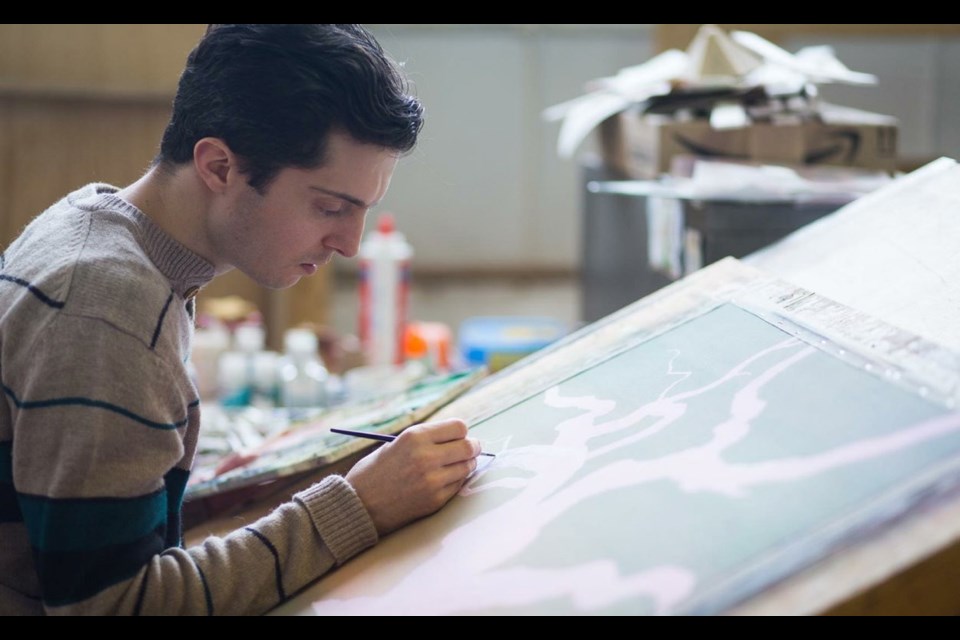What: J. Fenwick Lansdowne book launch and exhibition with Tristram Lansdowne
When: Saturday, 2 p.m. to 4 p.m.
Where: Winchester Galleries Oak Bay
A chain-link fence cordons off a plume of cotton-candy-coloured smoke. A shuttered office floats in negative space, supporting three hammocks where its basement would be. And the exposed layers of plaster and paint on an abandoned building’s face show the histories casually written and rewritten on a place.
At first glance, Tristram Lansdowne’s architectural watercolours don’t have much in common with the illustrated bird species that filled the canvases of his late father, J. Fenwick Lansdowne.
But in putting together a book of his father’s work, which will be launched Saturday, Tristram said he learned they had more in common than he realized.
“I learned a lot about his work, and I think it was a way for me to come to terms with his influence on my work,” Tristram said from his home in Toronto.
Fenwick had an established career by the time Tristram and his sister were kids. While other children might find paperwork and office supplies in their parents’ work space, the Lansdowne kids could pull open cabinet doors to find preserved bird skins, which Fenwick used as models, tucked away on shelves.
“It was an environment full of curiosities to explore,” Tristram said. “That was a really enchanting aspect of his household.”
Tristram rarely saw his father at work, however, because Fenwick treated art like a job and worked regular hours. Instead, Fenwick passed down his connection to the natural world in a more direct way; Birdwatching and beachcombing were regular activities for the Oak Bay family.
“He was sort of a naturalist as well as an artist. I think that had a big impact on us, more so than being in an artistic environment,” Tristram said.
Tristram always liked to draw and make art, but it wasn’t until he got to Toronto’s Ontario College of Art and Design University that his passion grew. At the same time, having grown up in the rich landscape of Vancouver Island where naturalism was emphasized, he was jarred by the concrete landscape of Toronto.
“I found it very difficult to feel at home.
“I felt it was very ugly and I felt claustrophobic. It was very flat, so you couldn’t see any landscape, only the buildings immediately in front of you,” he said.
He channelled that into his work, eventually deciding to focus on the buildings as subjects.
“I found the transitional areas of the city — the sort of derelict or hodge-podge, do-it-yourself constructions — very fascinating. The way people fixed up their sheds or the way that, when a building was torn down, you could see its imprint on the buildings that were beside it,” he said.
While Fenwick concentrated on wildlife, Tristram approached drawings of those structures in a similar way, floating them in the centre of a canvas and documenting them with meticulous detail.
“I think because of growing up with his work, I am more interested in representation and the mechanics of representation,” Tristram said.
“As soon as the representational aspect leaves, I become uninterested in making it.”
In a significant break from Fenwick’s approach, however, Tristram creates his own worlds, blending fantasy with reality. As he develops, Tristram says his paintings are becoming more divorced from reality.
Most of the works in the Winchester show were created between 2008 and 2010. Soon after that period, he began his popular “Islands” series: Vivid, utopian watercolours depicting worlds where architectural structures exist in energetic balance with thriving natural worlds.
Pieces from the series have been featured in Wired magazine and belong to the National Gallery of Canada’s collection.
This week, a show opened at Toronto’s LE Gallery highlighting his latest body of work, paintings that look like atmospheric disturbances go further.
“It’s representational, but you’re not even sure exactly what you’re looking at,” Tristram said.
“I think as my interest sort of changed and my confidence grew, I became more and more able to make fictional elements the focus.”
Next year marks a new chapter for Tristram, who will begin graduate studies at the Rhode Island School of Design, a new environment promising new inspiration.
But at the same time as looking forward, Tristram said it has been meaningful looking back on Fenwick’s life and career for the past three years.
In gathering images for the 184-page book, he has discovered a prolific young painter in his father.
He has found a hard worker, who would revisit an image several times until he got it right, even redrawing the same picture years apart. His sponge-like memory absorbed images of birds and recreated them on paper.
“He would see these things in the field, I guess, that would make an impression and he would work with that memory for years. It made me realize how detailed his memory must have been.”
The first time Tristram shared an exhibition space with his father, he was intimidated by the prospect.
“I didn’t want to put my work beside his, because he’s amazing and he’s been doing watercolours for 50 years. And I’d been making them for two,” he said.
The show was well-received. Now, with more experience under his belt and in tribute to his father, who died in 2008, he’s looking forward to it.
“Now I feel much more relaxed about it and not terrified by the prospect.”
